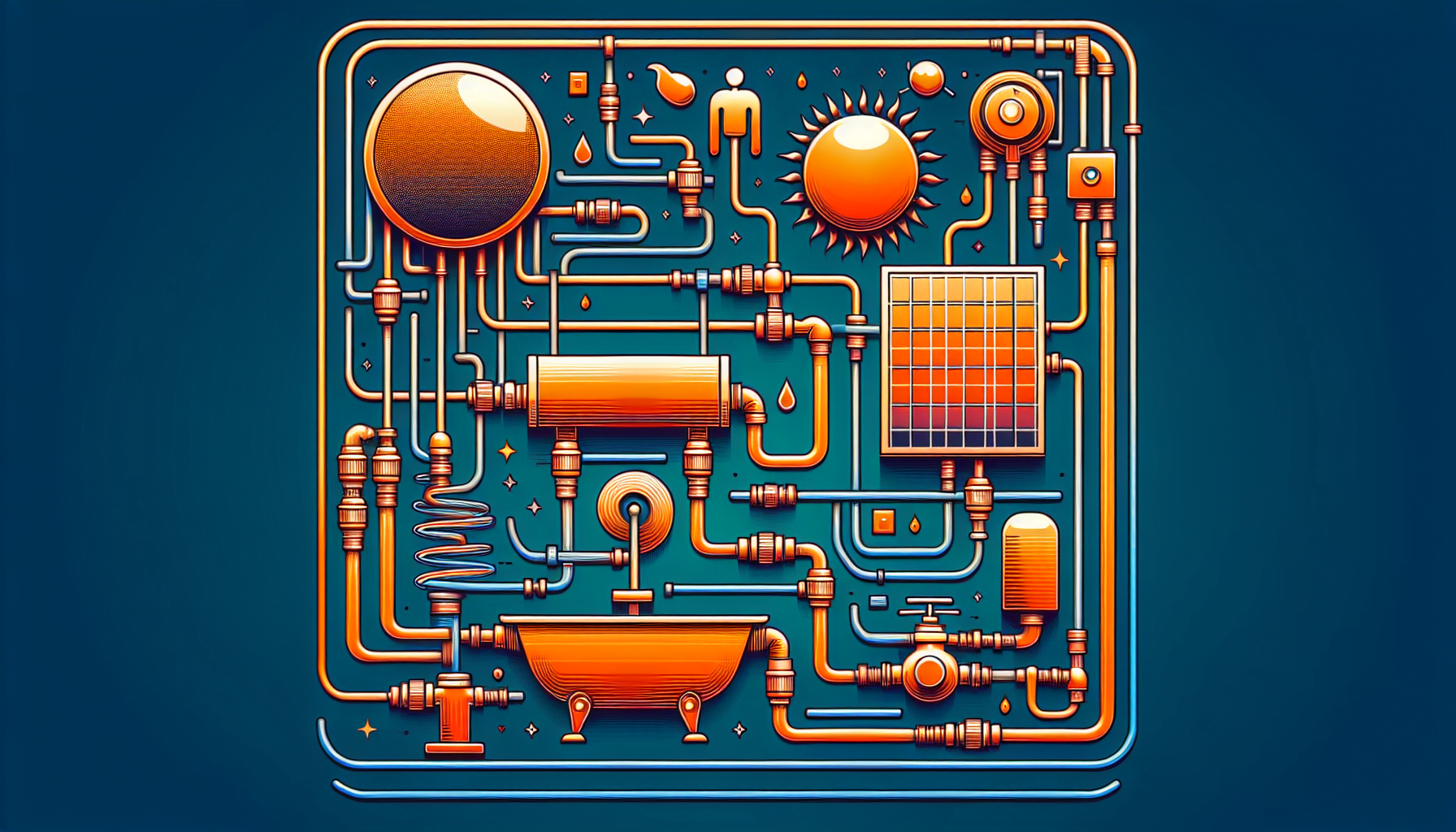A solar pool heater plumbing diagram is your blueprint to eco-friendly pool bliss. Imagine you’re all set to enjoy a warm swim, but you’re stuck staring at a tangle of pipes and valves, feeling the chill of confusion rather than the warmth of your solar-heated pool.
That moment of bewilderment? It’s the shared crux of every pool owner ready to embrace the sun’s power. But fear not, because clarity is on the horizon. With a few strokes of insight, we’ll navigate the maze of solar plumbing together.
You’ve felt the sting of a cold pool and the tug of a greener conscience. I’ve been there, squinting at indecipherable diagrams, until I decoded the secrets of solar heating systems. Let’s dive into the warm waters of understanding, where every twist and turn of your solar pool heater’s plumbing becomes as clear as a sunny day.

Critical Plumbing Components for a Solar Pool Heating System

Harnessing the Sun: Solar Panels and Collectors
You’re looking to dive into the world of solar pool heating, right? Well, the heart of your system lies in the solar panels and PVC tube collectors. These are the dynamos that capture the sun’s energy. Picture this: a network of panels, usually mounted on your roof, where the sun’s rays are absorbed and transferred to heat water. It’s like laying out a picnic blanket, but instead of food, you’re serving up warm, inviting pool water.
Smart Regulation: The Solar Controller
Now, let’s talk brains-the solar controller. This is your system’s command center, ensuring everything runs smoothly. It’s like having a smart thermostat, but for your pool. The controller monitors the temperature and directs water to the solar collectors when heating is needed. It’s a delicate dance between the sun’s availability and your pool’s temperature, all choreographed by this nifty device.
Manual Kit: Your System’s Handy Toolkit
Think of the manual kit as your pool heating’s Swiss Army knife. It’s the collection of valves, switches, and gauges that lets you tweak the system manually. Want to bypass the solar heating on a scorching day? That’s where your manual kit comes into play. It’s hands-on control for those who like to steer the ship themselves.
Timing is Everything: The Timer System
Timing is indispensable, and the timer system in your solar pool heating setup is like the punctual friend who never misses an appointment. It decides when to pump water through the solar collectors based on the best times for solar gain. Imagine it as setting an alarm clock for your pool to soak up the sun’s warmth, ensuring it’s ready when you are.
Stay Prepared: The Replacement Kit
Plumbing Configuration and Water Flow Optimization for Solar Pool Heaters

Optimal Valve Placement for Efficient Heating
You’re looking to harness the sun’s power for your pool, right? Well, the journey starts with the heart of your solar pool heating system: the valves. Think of them as the conductors of an orchestra, directing the flow of water where it needs to go. You’ll want to place these valves strategically to ensure that water circulates through the solar collectors effectively. This means integrating check valves to prevent backflow and using diverter valves to direct the flow between the pool and the solar system. It’s like setting up a road map for your pool water, guiding it smoothly from the pump to the solar collectors and back.
Connecting to the Pool Pump: The Lifeline of Your System
Now, let’s talk about the pool pump. It’s the lifeline of your solar pool heater, pushing water up to the roof where the solar collectors sit, basking in the sun. You’ll connect the pump to the solar system using reinforced flexible hoses or rigid PVC piping, depending on your setup. Ensure the connections are tight and leak-free – you don’t want to lose a single drop of that precious, sun-warmed water. It’s like ensuring every drop of water gets a chance to soak up the sun before diving back into your pool.
Auxiliary Heaters and Chlorination: The Support Cast
You’ve got your solar heater doing the heavy lifting, but what about those cloudy days? That’s where auxiliary heaters come in, ready to step up when the sun takes a break. You’ll integrate them into the plumbing configuration, ensuring they work in tandem with your solar setup. And let’s not forget about chlorination systems. They’re necessary for keeping your pool water clean and clear. You’ll want to place them after the heated water returns to the pool, ensuring the chemicals distribute evenly. It’s like having a backup dancer ready to jump in, keeping the performance flawless.
Directional Control and Isolation Valves: Choreographing Water Flow
Imagine you’re a DJ, mixing the perfect track. That’s what you’re doing with directional control and isolation valves. You’re choreographing the water flow, deciding when it goes through the solar collectors or straight back to the pool. These valves let you isolate parts of the system for maintenance without draining the whole thing. It’s about having control and flexibility, tweaking the system to match the day’s needs. Whether it’s a hot summer day or a cool evening, you’re in charge of the temperature tune.
Spa Operation Considerations: The Delicate Dance
If you’ve got a spa, you know it’s a different beast. It needs higher temperatures and more precise control. You’ll use a three-way valve to direct water to the spa when it’s time to heat up. It’s a delicate dance, balancing the needs of your pool and spa, ensuring both get the right amount of heat without stepping on each other’s toes. You’re the choreographer, making sure every part of your water wonderland is in harmony.



